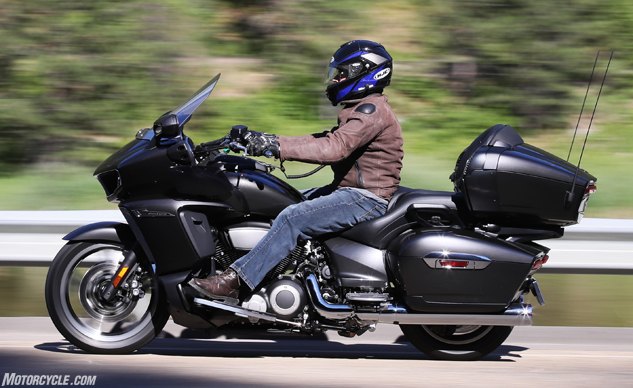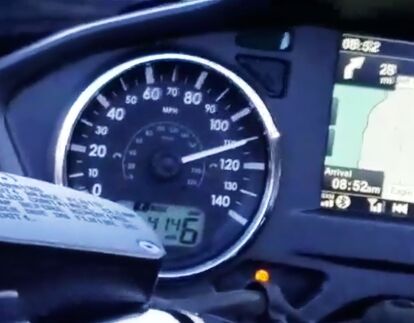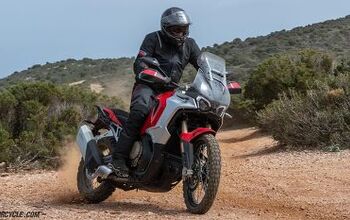2018 Yamaha Star Venture First Ride
I have to admit I’ve been around long enough to have ridden the original Yamaha Venture Royale, and quite a lovable beast it was. Then there was a Royal Star Venture in the intervening years, but it wasn’t so luxurious. Now there’s this all-new Star Venture, with which Yamaha says it’s officially re-entering the luxury-touring category.
2018 Yamaha Star Venture
| Engine | 18.0/20 |
| Suspension/Handling | 14.0/15 |
| Transmission/Clutch | 9.5/10 |
| Brakes | 9.0/10 |
| Instruments/Controls | 4.75/5 |
| Ergonomics/Comfort | 9.75/10 |
| Appearance/Quality | 9.0/10 |
| Desirability | 9.0/10 |
| Value | 8.0/10 |
| Overall Score | 91/100 |
Not only do Yamaha reps say this is one of its most important new models in years, they also like to think they’ve created their own little niche; this one’s a luxury tourer that combines traditional/emotional components (humongous V-Twin), with cutting-edge modern styling and all the luxury features you’d expect on a $25k touring bike. (If we must discuss money, the base model is $24,999 and the Transcontinental Option Package makes it $26,999.)
You’d be forgiven for thinking it’s the same old 48-degree V-Twin from the Roadliner/ Raider line, since it’s also 1854cc (113 cubic inches) via 100 x 118mm bore and stroke, but Yamaha tells us the beast has been completely redone, and now incorporates a six-speed gearbox with its output shaft exiting on the opposite side of the bike. There’s also a new cush drive built into the primary drive to soften the juddery hard edges that are kind of inherent to really big V-Twins at lower rpm. Yamaha seemed really proud of it – and I’d like to get more specific – but the description shown to us in a Powerpoint presentation during our briefing was no longer available when I sat down to write this.
Here’s what we did get: The Star Venture boasts a massive and torque-rich 113 cubic inch (1854cc) air-cooled V-twin engine with a class-leading 126 pound-feet of torque providing smooth and responsive power delivery even when fully loaded. The huge torque and relaxing V-twin pulse are complemented by lightweight forged alloy pistons, carefully-tuned twin counterbalancers and advanced composite engine mounts, which combine to deliver a smooth and comfortable ride on long days in the saddle while reducing fatigue. The engine’s semi-dry-sump design lowers the effective center of gravity by allowing the engine to sit lower in the frame. An external oil tank is integrated into the aluminum subframe to centralize mass and reduce weight, and a compact oil cooler is hidden between the front frame downtubes to help maintain ideal engine temperatures.
There was also a very cool line drawing of the new double-downtube steel frame the bike uses, along with its aluminum subframe. Those new “composite” mounts transfer into everyday speak as rubber, but the line drawings showed some kind of Buell Uniplanar or H-D FL-like deal that restricts the engine’s movement to the vertical plane. Those and the primary cush drive add up to the smoothest big V-Twin I’ve ever ridden, both accelerating from a stop but especially cruising along at 80 mph and 2800 rpm. (And even moreso at 100 mph and 3500 rpm, where the thing is perfectly serene. If you live in Montana or Germany, this is your big touring cruiser.) Some big Twins, most big Twins as I remember, start feeling a bit vibey when you’re really in a hurry. Not this one.
Two-creature comfortable
Comfort, of course, is job one when it comes to luxury touring, and this bikes gives you 957 pounds of it – 963 for our bikes outfitted with the Transcontinental Package, which ads GPS navigation, SiriusXM, additional speakers and Yamaha-exclusive Dual Zone audio control. Also LED fog lights, a couple of additional storage cubbies and an alarmed security system which gives me Space Invaders PTSD every time it activates itself. Which it does a lot. That’s a lot of motorcycle, in fact I think the heaviest one I’ve ridden since Roaddog. But it never feels like it. Strange.
The passenger backrest is 17 inches across, I believe the press materials said, which should be wide enough for any North American, and there’s plenty of room fore and aft also to give rider and passenger some space. To prove it, Yamaha even invited us to bring a passenger, which all of us did. I chose a smaller, hundred-pound model called Chrissy Rogers, just to keep things slightly lighter. She also has some fused vertebrae and zero experience on back of a big motorcycle, so I was braced for anything and ready to accept any useful critique or blows to the head and kidneys. After the Japanese techs along for the ride (in a minivan) adjusted the passenger floorboards into their high position, she had no complaints and nothing but happiness after two days in the saddle. Happy enough that I even got some nice massages en route. I could get used to traveling like this…
Come to think of it, my own hindquarters felt great too, so did my shoulders and back. That low seat is plush but supportive, and the backrest is three-way adjustable fore and aft. Forward worked great for my 30-inch legs. (One taller guy expressed his back was killing him even with it all the way rearward.) Long floorboards mean you can move your dogs into a variety of positions. Cruise control, of course, means you rest that right paw as needed.
The wind-tunnel-tested windscreen adjusts up and down 3.6 inches. It was best for 5-foot-8 me all the way down, where the top edge is just below my line of sight. But Christine liked it better, far better, all the way up, where it was less blustery for her. And there was no way of not acceding to her wishes thanks to the intercom. Up or down was a little blusterier for me than it might’ve been, though, I think because the Yamaha doesn’t use a low-pressure relief hole at the base of the screen like many others do. The styling department must’ve won that one.
Nobody likes it hot
Heat management is an issue on all big air-cooled bikes like this one. On the Yamaha in a pair of normal jeans, the backs of my legs only really felt it when temps climbed above about 88 (according to the TFT display), and really only in slow going. I’d give the Venture about a “B” for heat control. It’s hotter than the typical H-D dresser, not as hot as the Indians. Christine says it was only a problem when she stuck her boots onto my floorboards occasionally for a stretch but really because she craves constant attention.
Infotain me
Your base model bike gets two stereo speakers up front, your deluxe model gets two more in the back. Yamaha’s music department stepped in to lend a hand in its design, I’m told, and it sounds great. But at 28 watts per channel, it can’t compete at highway speed with the more powerful systems on the Indian Chieftains we rode awhile ago in San Diego, whose stereos go to 11. Natch, you got AM/FM, weather band and all that, and it’s a snap to Bluetooth it up to whatever you like with your own music, plus Pandora, etc., and Sirius XM (on the Transcontinental) for when you’re out of cell-phone range, which is most of the time on this bike. Yes, there’s a CB.
Our helmet speakers were hard-wired into the bike, which was kind of a PITA, but Yamaha says there are too many transmissions going on for Bluetooth to handle all of them at once at this time. Our main problem with the intercom was it wouldn’t mute the external speakers when the mic was keyed, which made it hard to hear each other over all the head-banging tunes we were cranking: Turning down the speaker volume also turned down our intercom volume. Probably operator error, since nobody else was having that problem. Or admitted to it.
There are a million functions and adjustments built into the Infotainment system (with seven-inch screen), and the manual is 116 pages. Have a look if you’re a techie. Among the tricks you’ll learn to perform is to place phone calls with voice commands, program the little voice in your head to read your texts (in English or French) when you’re on the move… and the bike will even send you messages if a tire or the remote fob battery is low. With the Dual Zone audio systems on the Transcontinental, you can listen to one channel while your radio officer listens to something else. The most valuable function may be the ability for your passenger to have a phone conversation while you “deselect” yourself and listen to music.
I had trouble with the little buttons on the left handlebar; luckily the TFT is also a touchscreen that works great even with gloved fingers.
Speaking of the little voice, the Transcontinental also gets an advanced navigation system with all the adjustable functions you’d expect. Our route was laid out ahead of time on a thumb drive and inserted into the USB port. There would be no excuses for getting separated from the group and lost on this ride. Even if I’d been able to switch the voice directions to French, there was no missing the arrows on the screen telling you to turn left or right 500 yards in advance. Now go straight for 28 miles…
Ride/handling
As you’d expect from Yamaha, the Venture goes, stops, and corners really well considering the size of the package, with extreme stability and a rock-solid feel at any velocity of which it’s capable. Not that we got the chance to really blitz any backroads; passing Yamaha’s lead rider for some reason didn’t feel like it would be the politically correct thing to do, though like I mentioned earlier, the thing felt just as planted at over 100 as it did at 65 mph. A couple of times I did drop back from the group in some tight sections of road so I could catch back up, and the steering is light enough, linear and very accurate, with good feel. You’re going at a pretty good pace when the floorboards start throwing sparks. Braking and turning with the really strong and progressive (linked) brakes is no problem. Feel free to ride this one like the world’s biggest sport-tourer.
Then again, that’s loaded with maybe 300 pounds total of human and gear, and your only suspension adjustment is rear preload. Structural integrity-wise, it reminds me of the Victory Cross Country Tour I got to spend a few weeks on a couple years ago – but it is sadly no longer with us.
More grunty than revvy
For me, we could use a few more rpm. That claimed 126 ft-lbs of torque comes at just 2500 rpm, which is nice, but you bump into a strict rev limiter just 2000 rpm later, at 4500. I get that there’s not much payoff in revving the big Twin past that (though the Raider the engine’s based upon made max power at 4600 rpm), but sometimes you just wanna peel out and wow the crowd a little. Sometimes you’d like to hold a gear a bit longer between corners. I bumped against the rev limiter lots of times – many of them just to be obnoxious if I’m honest. You do get used to the low rev ceiling, but I’d be happier with another 500 rpm.
Elsewhere in the powertrain, the slip-assist clutch is light and progressive, the new six-speed gearbox drops clunklessly into first, and shifts light and positively between all the other gears – including overdriven 5th and 6th.
Little things can move mountains…
Sure Park parking assist is a stroke of genius. Sure, other bikes have had reverse forever, but being able to move this 950-pound bike in both directions without the need to start the engine is a thing its owners will no doubt really appreciate when trying to wedge in and out of tight spots without waking everybody up.
You may have to own the Venture a while to remember how to operate all its systems. The fuel filler door will only open when the ignition is OFF and the button is held down for two seconds. (Or use the remote, which will also home in on your bike if you lose it in a big parking lot.) People who are proficient with their personal electronic devices (Evans Brasfield) will love all the Infotainment system offers. Some of us technophobes will need years of remedial training. But even I had mastered the basics by the end of day two (maybe not mastered), but luckily I’m still entertained by the voices in my head anyway.
Style
As a sportbike guy, I love the menacing giant R1 facade melding into the ’65 T-Bird tail. Parts of the dashboard are a little plasticky, but not too bad. And the effortless way the thing swoops along makes you forget its few shortcomings. What shortcomings?
Here we’re parked above White Bird Battlefield, where the Nez Perce tribe got into a little incident with the U.S. Cavalry that didn’t end well for 34 troopers (in spite of the fact that, according to Wiki, “the Nez Perce had stolen a large quantity of whiskey in their raids and, on the morning of June 17, many of the men were too drunk to fight.”) Stuff happens.
Later, it didn’t end well for the Nez Perce. But it’s still God’s country all over up in here, children, along the Salmon River and the Payette, McCall and Coeur d’Alene, and the new Star Venture is a pretty damn deluxe way to see it. These will be in dealers in August, Yamaha says, and in the meantime they’re schlepping them all over the country for test rides, including the the big Star Days fest, which is going on in Red Wing, Minnesota, as we speak.
To paraphrase Chief Joseph, I will fight the giant luxury touring bike no more forever.
2018 Yamaha Star Venture
+ Highs
- Smooth running mile-muncher
- Expansive, luxe accommodations for two
- Five-year warranty
– Sighs
- I’d like another 500 rpm before banging into the limiter
- Windscreen is a tad blustery but I can fix that with a hole saw
- Where is the karaoke machine?
2018 Yamaha Star Venture Specifications | |
|---|---|
| MSRP | $24,999 base, $26,999 with Transcontinental Option Package |
| Engine Type | 113-cubic-inch (1854cc) air-cooled OHV V-twin; 8 valves |
| Bore x Stroke | 100.0 mm x 118.0 mm |
| Compression Ratio | 9.5:1 |
| Fuel Delivery | Yamaha Fuel Injection with YCC-T and D-Mode |
| Ignition | TCI: Transistor Controlled Ignition |
| Transmission | 6-speed; multiplate assist and slipper wet clutch |
| Final Drive | Belt |
| Front Suspension | 46mm telescopic fork; 5.1-in travel |
| Rear Suspension | Single shock with remote preload adjustment; 4.3-in travel |
| Front Brakes | Dual hydraulic disc, 298mm; Unified Brake System and ABS |
| Rear Brakes | Hydraulic disc, 320mm; Unified Brake System and ABS |
| Front Tires | 130/70R18 Bridgestone Exedra |
| Rear Tires | 200/55R16 Bridgestone Exedra |
| Length | 106.3 in. |
| Width | 39.9 in. |
| Height | 55.5 – 59.1 in. |
| Seat Height | 27.4 in. |
| Wheelbase | 67.6 in. |
| Rake (Caster Angle) | 31.0° |
| Trail | 5.7 in. |
| Max. Ground Clearance | 5.5 in. |
| Fuel Capacity | 6.6 gal. |
| Fuel Economy | 42 mpg (trip computer), 34.0 mpg (Yamaha website) |
| Wet Weight | Star Venture / Star Venture Transcontinental 957 lb / 963 lb (claimed) |
| Warranty | 1 year limited factory warranty + 4 years Yamaha Extended Service |
More by John Burns



































































































Comments
Join the conversation
Uh, "You’d be forgiven for thinking it’s the same old 48-degree V-Twin from the Roadliner/ Raider line, since it’s also 1854cc (113 cubic inches) via 100 x 118mm bore and stroke." Really??
The "same old" 113ci (1,854cc) motor in the Stratoliner/Roadliner generates significantly more hp (10+) and more torque (5 additional ft-lbs) than the "new and improved" Star Venture motor. To wit, Rider Magazine dyno test of 2011 Stratoliner Deluxe with the "old" motor; 88 hp and 114 ft-lbs of torque. Rider Magazine dyno test of 2018 Star Venture; 76 hp and 109 ft-lbs of torque. Disclosure: I own a Stratoliner (and love it).
Hey Yamaha, if I buy a Star Venture can I transplant my Stratoliner Deluxe motor to my new bike??
I have a 2018 Star Venture Transcontinental and I have no complaints with the stereo, mine puts out clean pure sound even at highway speeds. Glad to read about the tip over not causing damage, overall this is a pretty good review of the bike.